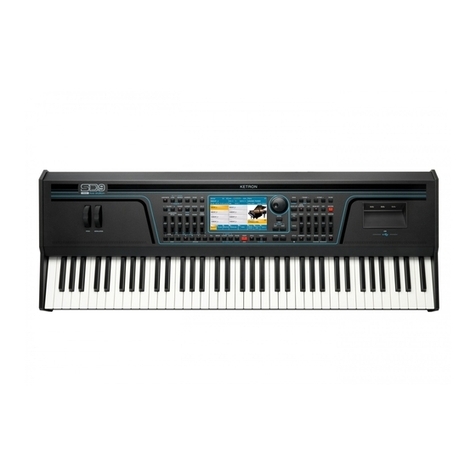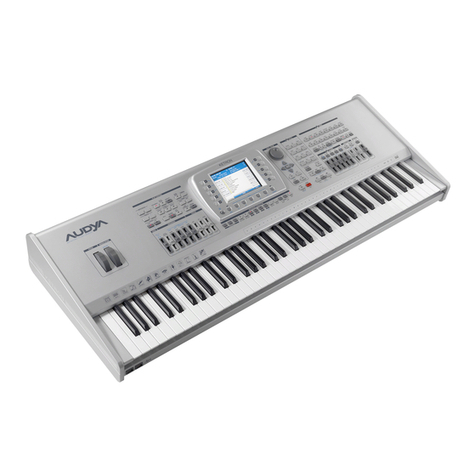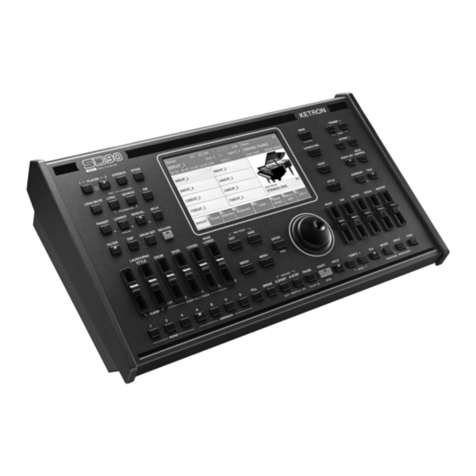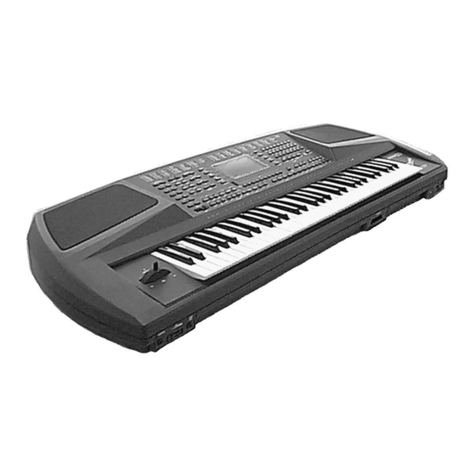TTiimmbbrree sseelleecctteedd aanndd vvoolluummee::To change the timbre in use on the Right lead section use the VOICES push buttons relative to the single group
or the USER VOICES push button. The pair o RIGHT VOLUME push buttons are used to modi y the volume o the timbre.
Second Voices: This indicates a second timbre to be overlapped on the Right lead section. It is entered using the 2ND VOICE push button.
SSpplliitt ppooiinntt aanndd ttrraannssppoossee: This indicates the note to the right o which the lead or Right section dedicated to the right hand plays. To the le t
on the other hand the part o keyboard used to acknowledge the chords or the arranger and or the notes to be played in the Lower section
with the le t hand are situated. The modi ication is achieved using the SPLIT push button as already described previously. Transp. This indi-
cates the transpose semitones that can be modi ied using the CURSOR + and CURSOR - push buttons. When a double dash is displayed trans-
position is not present.
TTeemmppoo aanndd bbeeaatt oo tthhee ssttyyllee::This indicates the current Tempo o the Arranger. Use the PAGE + and PAGE – push buttons to modi y it. The beat
indicator is used to avoid visually loosing the rhythm o the style being played.
CChhoorrdd::This indicates the chord currently being played. To change it play another chord on the part o keyboard to the le t o the Split point.
Volume cursors o the main sections o the keyboard These graphically display, with absolute value, the state o the volume o the Drums, Bass,
Chord, Orchestral, Lower and Right sections, the value o which can be directly modi ied using the pair o VOLUME push buttons.
To modi y the display contrast turn the CONTRAST wheel on the control panel.
A set o unctions corresponds to each unction push button F1/F10, in the main page o the display, which can be directly accessed by press-
ing the relative push button.
F1 GM: This selects the menu with the parameters relative to the single MIDI parts o the sixteen o ered by the standard General MIDI.
F2 EFFECT: This is used to rapidly modi y the Reverbs and to enable the modulation e ects and also to access the single parameters o the
single e ects.
F3 UTILITY: This controls the overall parameters o the keyboard and the physical controllers.
F4 ARRANGE MODE: This is used to gain access to the parameters dedicated to the Arranger when playing live.
F5 ARRANGE VIEW: Four menu pages o er the possibility to re-program the timbres, volumes and e ects o each single section o the Arranger.
F6 MIDI: Via the sub-menus access is gained to the programming o MIDI events even in transmission and reception mode and to the assign-
ment unction o the MIDI channels to each single section o the keyboard.
F7 EDIT VOICE/DRAWBARS: This is used to modi y the main parameters relating to the timbre such as the envelope, the ilter and the modula-
tions. When the LED o the DRAWBAR push button is lit, access can be gained to the programming unction and display o the single Draw
bars to create new organ sounds by pressing the EDIT VOICE/DRAWBARS push button rom the main page o the display.
F8 EDIT PROGRAM: This is used to program or modi y the parameters relative to the our timbres that can be used at the same time or the
lead section.
F9 EDIT DRUM: For the drum tracks and not only. This group o unctions is dedicated to the programming o a complete drum kit, o which
up to two samples can be indicated or each key o the keyboard.
F10 MICRO EDIT: This is related to the use o microphones and to the two relative inputs with the possibility to modi y the volume and the entity
o the various e ects (Send).
THE PUSH BUTTONS AND THE CHOICE OF THE STYLES
Twelve push buttons are used to call up just as many groups o styles directly rom the control panel. When a group is selected the display shows
ive styles to the le t and another ive to the right. To enable a style simply press the relative unction push button at the side o the display.
Considering that the SD1 o ers more than ten styles per group, the user can move onto the next pages either using the PAGE + and PAGE –
push buttons or by pressing the push button relative to the group o styles in use again. When the SD1 reaches the last page o styles available,
the user can return to the irst page by pressing the push button relative to the group o styles again and not the PAGE + and PAGE – push
buttons.In some editing situations the twelve STYLES push buttons become numeric keys that are used to enter the value directly.
THE PUSH BUTTONS AND THE CHOICE OF THE VOICES
The two rows o eight push buttons called VOICES are used to call up timbres or Preset Voices (that cannot be modi ied by the musician) accord-
ing to the amily to which they belong. When a amily is selected with one push button the display shows ive Voices to the le t and ive Voices
to the right, which can be enabled by pressing the unction push button relative to that timbre. Considering that the SD1 o ers more than ten
Voices per amily, the user can move onto the next pages either using the PAGE + and PAGE – push buttons or by pressing the push button rel-
ative to the amily o Voices in use again. When the SD1 reaches the last page o Voices available, the user can return to the irst page o Voices
by pressing the push button relative to the amily o Voices again and not the PAGE + and PAGE - push buttons.
The VOICES push buttons are not only used to call up the pre-set voices alone.
●I the LED o the USER VOICE push button, i.e. o the bank o timbres that can be programmed by the user is activated, then the VOICES
push buttons call up the 128 User Voice timbres in groups o ten at a time.
●I the LED o the DRAWBAR push button is lit, an organ timbre corresponds to each single VOICES push button.
Owner’s Manual SD1 9




































